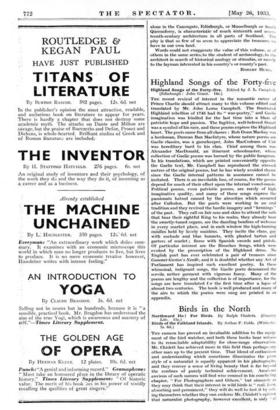Birds in the- North
Northward Ho ! For Birds. By Ralph Chislett. (Country Life. _ I5s.) Birds of the Faildand Islands. By Arthur F. Cobb, (Witherby.
7s. 6d.) _
THE camera has proved an invaluable addition to the equip- ment of the bird watcher, and both these books 'bear witness to its reinto*able adaptability for close-range observation. • Mr. Chislett has achieved more in this field than perhaps any other man up to the present time. That blend of enthusiasm "and understanding which sometimes illuminates the prose _style of a naturalist is equally apparent -in -his photographs, and they convey a sense of living beauty that is far beyond the confines of purely technical achievement. Amateurs envious of such success will find wise counsel in his concluding -chapter, " For Photographers and Others," but sincerely as -they may think that their interest in wild birds is real, keen, abiorbink and permanent,", they will do well to test it by ask- irigthemselves whether they can endorse Mr. Chislett's opinion that naturalist photography„-however- excellent, is :Only " of
secondary importance to the preservation of a priceless national possession, which once destroyed cannot be re- placed."
Mr. Chislett's book is a record of observations carried out at different periods on the Derbyshire moors, in Scotland (Galloway, the Highlands, Sutherland), in Shetland, Oland and Lapland. Of especial interest are some quite extra- ordinarily beautiful pictures of the greenshank and a detailed
account of the conditions under which they were obtained, a photograph of the Slavonian grebe—a rare achievement for Scotland—and photographs of the whimbrel in its Shetland breeding quarters. In Oland Mr. Chislett was working hr territory hitherto uncovered by British photographic naturalists, and among his rewards were studies of the black- tern and the turnstone. The inconveniences that Lapland has in store for ornithologists are well enough known, but so also is the fascination it exercises over those who visit it. In his first exploration of a Lapland marsh Mr. Chislett discovered a jack snipe's nest and later secured a photograph of the bird sitting, which must have compensated him for many subsequent disappointments. He has visited the country twice, and it is to be hoped that his own wish to return there and implement this extremely interesting recd: d of its forests, marshes and mountains, may be fulfilled.
Mr. Cobb's Birds of the Falkland Islands is a much shorter book, but he describes and illustrates with photographs some, thirty-one different species with which he has become familiar during the course of a long residence in the territory. One or two of the photographs are not entirely successful in " showing the beauties of Nature in the Falkland Islands " as clearly as the author would wish, but his notes reveal a faculty for observation and concise description that makes them a useful contribution to the study of this region.

















































 Previous page
Previous page